|
Home - Beginner's Guide to Cherry Blossom Viewing in Vancouver
There are several thousands of cherry trees of over twenty different species in the streets, parks and gardens of Vancouver. A large majority of them are Japanese Flowering Cherries whose purpose is ornamental rather than agricultural. Most of the trees do not produce edible fruits, but instead were cultivated to look beautifully especially in spring when the blossoms are in bloom.
Basic Vocabulary:
Sakura = Cherry Tree
Hanami = Cherry Blossom Viewing
Mankai = Full Bloom
Yaezakura = Cherry Tree with blossoms consisting of more than 5 petals
How to enjoy them
Simply enjoy the intensity of the large numbers of blossoms by looking at a single tree or groups of trees. From a distance, the trees appear as beautiful white and pink clouds, while the beauty of single blossoms can be enjoyed from a close distance.
Have a pick nick under the blooming trees. There are a few locations in the city's parks that are very suitable for hanami pick nick parties. Click here for an overview over the best hanami locations.
The species
As mentioned above, over twenty species of cherry trees can be found in Vancouver. But only two of them can be found in abundant numbers, while most others are relatively to very rare. The two most numerous species are:
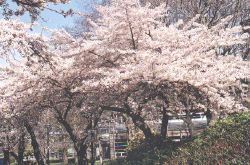
Yoshino Cherry
|
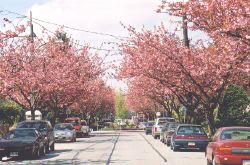
Kanzan Cherry
|
Yoshino Cherry (Somei Yoshino)
This is probably Japan's most popular cherry tree, and is also planted in large numbers throughout the city of Vancouver. It produces white blossoms of five petals and usually flowers in early to mid April. Many Japanese people will associate this tree most readily with the hanami season and cherry blossoms in general.
Kanzan Cherry
This is North America's most popular, and Vancouver's most numerous Japanese cherry tree species. It usually flowers in mid April to early May about two to three weeks after the Yoshino Cherry. Its blossoms are dark pink and consist of over twenty petals each.
How do species differ from each other?
There are several characteristics that differ between the various species. Some of the obvious ones, that can also be easily recognized by beginners, are:
- Number of petals:
Wild trees but also a lot of cultivated tree species have blossoms of five petals. But there are other species with blossoms of more than five and as many as fifty to one hundred petals per blossom. Trees with blossoms of more than five petals are called yae-zakura.
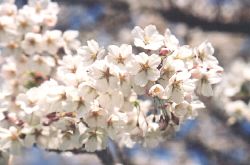
5 petals
|
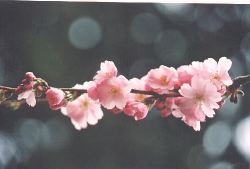
about 10 petals
|
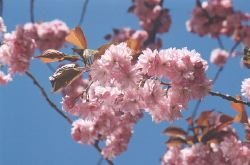
about 50 petals
|
- Color of the blossoms:
Most species produce lightly pink to pure white blossoms, but there are also cherry trees with dark pink or slightly yellowish blossoms. The color of the blossoms of some species is also changing while they are in bloom. For example, the blossoms of some trees may fade from a dark pink to a brighter pink over the days or the other way around.
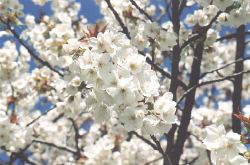
white flowers
|
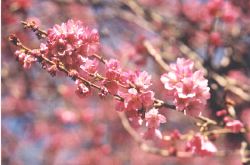
pink flowers
|
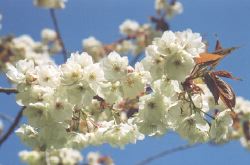
yellowish flowers
|
- Time of flowering:
Most species flower sometime in spring, even though there is also at least one species that flowers in the autumn and winter months. Late March to early May is the time when the largest number of cherry trees is in bloom, but there are some species flowering earlier and later. Furthermore, the flowering time varies from year to year depending on the weather and especially the temperature.
- Duration of flowering:
The lifetime of the blossoms of most Japanese cherry trees is not very long. In many cases the trees reach full bloom within about a week after the blossoms opened, and already start to decline about three to four days later. Furthermore, heavy rain and wind can reduced the flowering duration. A few species flower over longer time periods of several weeks.
- The fresh leaves:
In case of early flowering trees, the fresh leaves usually do not appear until after full bloom which gives the trees a very attractive, homogenous look. In case of later flowering trees, the leaves usually appear at the same time or even before the blossoms. Also the color of the fresh leaves differs greatly between the species. The fresh leaves of most species are either green or coppery brownish.
- Form of the tree:
Cherry trees of different species display various growing habits and come in various shapes and forms: triangular, columnar, V-shape, weeping, flat-topped, etc.
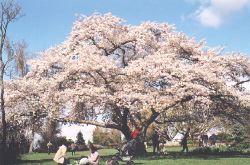
triangular tree
|
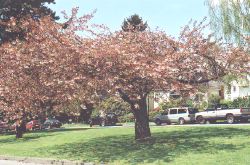
flat-topped tree
|
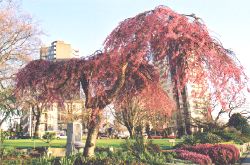
weeping tree
|
When do they bloom?
This depends on the cherry tree species. To simplify the matter, Vancouver's cherry blossom season can be divided into three phases:
- Phase 1: Early flowering trees (February to March)
There is a small number of cherry tree species that flower as early as February and March. However, the number of those trees is relatively small, so that they go unnoticed by the untrained eye.
- Phase 2: Yoshino Cherry Season (late March to mid April)
This is the time when the white 5-petal blossoms of the popular Yoshino Cherry are in bloom. This is the best season for hanami and a pick nick under the cherry trees in the park.
- Phase 3: Yaezakura Season (mid April to May)
This is the season when most yaezakura (trees with blossoms of more than five petals) are in bloom, most notably the numerous Kanzan trees.
Where do they bloom?
Cherry trees can be found along streets, in the city's parks and in private gardens. For an overview over some of the best locations to do hanami, click here.
Cherry Trees vs. Plum Trees - How do they differ?
Cherry trees take a very prominent position among Vancouver's blooming trees because of their beauty and large numbers, but they have competition: Plum trees are also very widespread in the city of Vancouver and probably about as numerous as cherry trees. The intricate thing is that the blooming season of plum trees overlaps with the one of many cherry tree species, and that plum trees and blossoms look very similar to cherry trees and blossoms.
The best way to distinguish them is by looking at their bark. The bark of cherry trees features horizontal lines, while the bark of plum trees does not. Of course, there are a few exceptions to this rule, but with it you will be right in most of the cases.
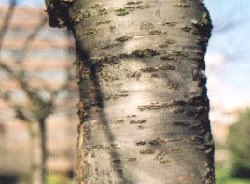 Bark of a cherry tree
Bark of a cherry tree
Furthermore, plum trees are flowering two to three weeks ahead of most species of cherry trees, usually starting in mid March. Most plum blossoms have five petals and come in white and variations of pink. Furthermore, plum blossoms tend to be more fragrant than cherry blossoms.
| 
